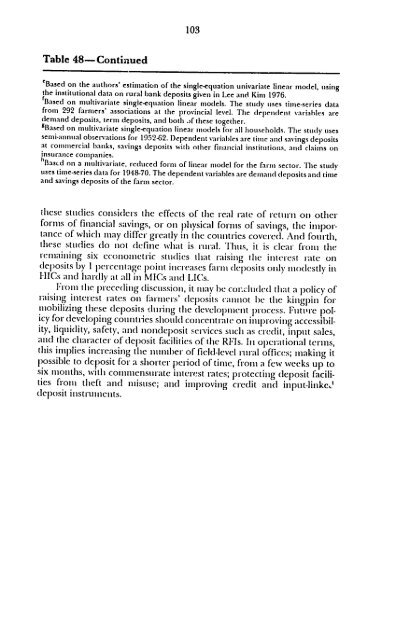I Fiance Apicultural
I Fiance Apicultural
I Fiance Apicultural
Create successful ePaper yourself
Turn your PDF publications into a flip-book with our unique Google optimized e-Paper software.
Table 48- Continued<br />
103<br />
eBased on the authors' estimation of the single-equation univariate linear model, using<br />
the institutional data on rural bank deposits given in Lee and Kim 1976.<br />
'Based on multivariate single-equation linear models. The study uses time-series data<br />
from 292 farmers' associations at the provincial level. The (epen(lent variables are<br />
demand deposits, term deposits, and both jf these together.<br />
gBased on tnultivariate single-equation linear models for all households. The study uses<br />
semi-annual observations for 1952-62. )ependent variables are time and savings deposits<br />
at commercial banks, savings deposits with other financial institutions, and claims on<br />
insurance companies.<br />
hBascd on a multivariate, reduced form of linear model for the farm sector. The study<br />
uses time-series data for 1948-70. The dependent variables are demand deposits and time<br />
and savings deposits of the farmn sector.<br />
these studies considers the effects of the real rate of rettrn ol other<br />
forms of financial savings, or on physical forms of savings, the inportance<br />
of whichi may differ greatly in the countries covered. And foturth,<br />
these studies do not define what is rural. lhtts, it is clear fiot the<br />
rtetaining six econometric studies that raising le interest rate on<br />
deposits by I perccntage point increases fatrn deposits only modestly in<br />
HICs and hardly at all in MICs and LICs.<br />
Irom the prece(ling discussion, it lay be Cotluded that a policy of<br />
raising interest rates otn fanters' deposits catnot be the kingpin for<br />
mobilizing these deposits dtring the development process. Futtt'e policy<br />
for developing couintries should concentrate on intprovitlg acccssibility,<br />
liquidity, safety, and nondeposit services such as credit, input sales,<br />
and the character of deposit facilities of the RFIs. In operational terms,<br />
this implies increasing the number of field-level rtt-al offices; making it<br />
possible to deposit for a shorter period of time, fi-om a few weeks up to<br />
six tnionths, with commenstirate intercst rates; protecting deposit facilities<br />
fiton theft and itistise; and improving credit and inpttt-linkc"<br />
deposit iinstrttments.

















